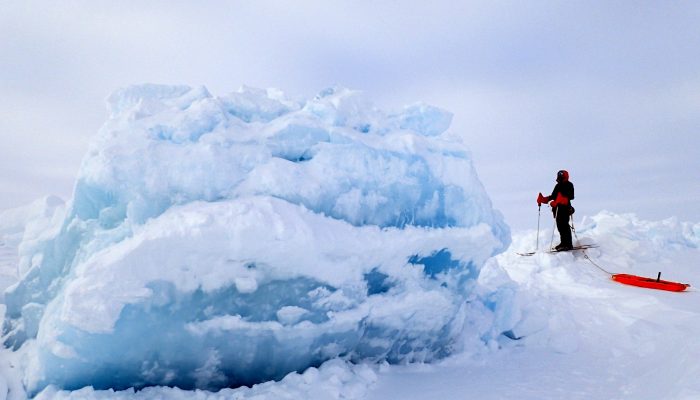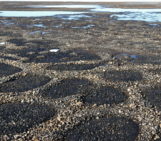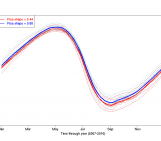
When I ask school children or people who only know about sea ice from remote references in the newspapers: ‘How thick do you think is the Arctic sea ice?’, I often get surprising answers: ’10 meters? No, it must be thicker – 100 meters!’. It seems like sea ice, often depicted as a uniform white cover around the North Pole and as a key element in accelerated warming of the Polar Regions, imposes a majestic image. Unfortunately, sea ice is much more fragile.
Growing in the current
Actually, sea ice is on average just about 2 m thick. It used to be thicker, up to 3 m, but such ice needs several winters to grow and is quite rare in the modern-day Arctic as winters are warmer than they used to be (see this previous post). Currently, more than half of the Arctic sea-ice area melts away completely during summer and grows back during the next winter. Such a thin layer of frozen water floating on the ocean is not strong enough to resist the forces of the wind, which pushes it around in ocean surface currents. In order for the ice to move, it has to deform and breaks into ice floes (read more in this previous post). Some ice floes move apart (divergence) in leads and polynyas (see this previous post), while others are pressed together (convergence) in pressure ridges, where blocks of ice pile up against and on top of each other (see our Image of the Week).
Ice grows from the ocean surface layer by water freezing. This is called thermodynamical growth. Thermodynamical growth produces most of the ice forming in the time from freeze-up in fall until the ice becomes about 1 to 2 m thick in mid-winter. At that point, sea ice approaches equilibrium thickness, i.e. the sea ice is thick enough to insulate the cold atmosphere from the relatively warm ocean. But because sea ice deforms, it can continue growing during the rest of the winter too. Pressure ridges sails can stick several meters out of the icy landscape, while their much larger and bulkier keels are hidden below the surface. Ridges can store large volume of sea ice – about a third (Hansen et al, 2013)! At the same time, new ice can grow in leads where open water is exposed to the atmosphere.
The following video is a collection of movies showing consequences and acts of sea-ice deformation. The first part is taken from R/V Lance – the ice-strengthened research ship of Norwegian Polar Institute, while she is navigating along a lead in late winter. Observe how much space is taken by pressure ridges! The second part of the movie shows a pressure ridge growing. Listen to the sound of deforming ice!
Another positive feedback
In winter, temperatures are so low that all the fractures, leads and pressure ridges freeze back – they heal. In summer, however, these damages are the first to appear again. Dark water with low albedo (read more about the albedo feedback in this post) is exposed and the ice melts faster in such regions. Because the Arctic sea ice became relatively thin over the recent decades, it also became less resistant to the forces of the wind. Such thin ice breaks more easily (e.g. Itkin et al, 2017). This means that, as more of such damaged ice is present in summer, the ice cover melts faster. So, here is an additional positive feedback for the Arctic ice under climate change: thinner ice melts faster also because it has become weaker and therefore breaks up easier.
Further reading
- Hansen, E., Gerland, S., Granskog, M.A., Pavlova, O., Renner, A.H.H., Haapala, J., Løyning, T.B., Tschudi, M. 2013. Thinning of Arctic sea ice observed in Fram Strait: 1990-2011. Journal of Geophysical Research: Oceans 118(10): 5202–5221. DOI:10.1002/jgrc.20393
- Itkin, P., Spreen, G., Cheng, B., Doble, M., Girard-Ardhuin, F., Haapala, J., Hughes, N., Kaleschke, L., Nicolaus, M., Wilkinson, J. 2017. Thin ice and storms: Sea ice deformation from buoy arrays deployed during N-ICE2015. Journal of Geophysical Research: Oceans 122(6): 4661–4674. DOI:10.1002/2016JC012403
- Image of the Week – Heat waves during Polar Night!
- Image of the Week – Sea Ice Floes!
- Image of the Week – What an ice hole!
- Image of the Week – The warming effect of the decline of Arctic sea ice
Edited by Clara Burgard
Polona Itkin is a Post-doctoral Researcher at the Norwegian Polar Institute, Tromsø. She investigates the sea ice dynamics of the Arctic Ocean and its connection to the sea ice thickness. In her work she combines the information from in-site observations, remote sensing and numerical modeling. Polona is part of the social media project ‘oceanseaiceNPI’ – a group of scientists that communicates their knowledge through social media channels:
Instagram.com/OceanSeaIceNPI, Twitter.com/OceanSeaIceNPI, Facebook.com/OceanSeaIceNPI, contact Email: polona.itkin@npolar.no





